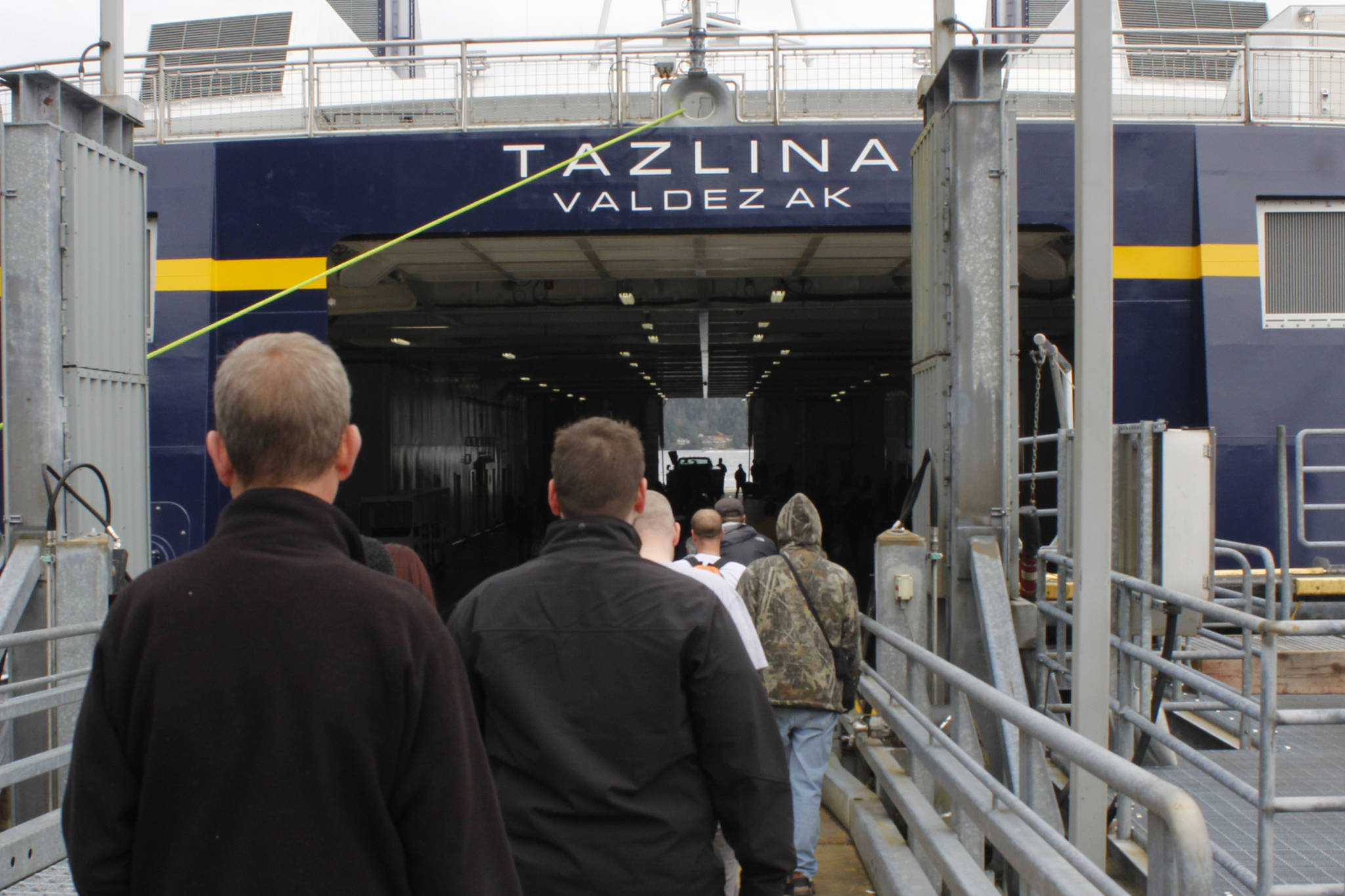It’s been a strange few weeks for Capt. Michael Schlechter.
Schlechter, who served on the F/V Fairweather for 15 years, steered the Fairweather on its final voyage in Alaska last month and piloted the new Alaska-class Ferry Tazlina up and down Lynn Canal last week.
“It’s been weird because I was the last captain on the Fairweather,” Schlechter said. “I took it down to Ketchikan, locked the door behind me and left, and then came over here and started the reverse process here.”
The door to the Tazlina was wide open Sunday, and about 800 people walked through the new ferry as part of an open house. Schlechter was one of many Alaska Marine Highway System or Department of Transportation and Public Facilities employees meeting people and answering questions. Many of the new crew members were crew members on the Fairweather, Schlechter said.
The Alaska-class ferry — which is the first of two — was constructed in Alaska by Alaskans, which was a source of pride for many on board. One of those was Sen. Bert Stedman, R-Sitka, who was one of the driving forces in getting the funding for the ferry. He said he was impressed by the workmanship on board and said he thought it was constructed better than previous ferries the state has gotten from out of state.
There was even a huge “Made in Alaska” sticker on the side of the boat that Stedman said was a pleasant surprise to him.
Juneau resident Christopher Coutu, touring the vessel with his wife and children, said the significance of the ferry’s in-state construction wasn’t lost on them.
“It’s exciting, I think, having a ship built in Alaska by Alaskans for Alaskans,” Coutu said, “and then coming in here and letting Alaskans come and look through the ship before its maiden voyage, I think it’s just great.”
The vessel was built specifically to withstand the rough conditions in Lynn Canal, DOT&PF Deputy Director Mary Siroky said on board. The fast ferries — the Fairweather and the Chenega — could never quite run as fast as they were designed to because of the tumultuous seas, she said.
Siroky said public feedback was vital in the process. At one point, the ferry was going to have an open-air car area, but members of the public were vehemently opposed to exposing their cars to the sea spray, so the Tazlina’s vehicle area is enclosed.
[Photos: Take a look inside Alaska’s newest ferry, the Tazlina]
The ferry will make the same two runs three times per week, DOT&PF spokesperson Aurah Landau said. The first day run will be Juneau to Haines, then Haines to Skagway, then Skagway to Haines. The ship will stay in Haines overnight. The next day, it will sail to Skagway, then back to Haines, and then to Juneau. The ship will then start that cycle over, and do it a total of three times per week.
The first voyage with passengers is scheduled for 7 a.m. Tuesday, and AMHS General Manager John Falvey said there are still tickets available.
While most of the feedback Sunday was positive, there were still concerns about the ferry system’s long-term future and how the Tazlina fits into that. With no crew quarters on the Tazlina, for example, the ship can only sail in 12-hour increments. There’s been talk about adding a new ferry terminal to make the runs shorter, but any change to the infrastructure is still likely a few years off.
Rep. Sara Hannan, D-Juneau, said it was fun to look around at the engine room and rest of the vessel, but she couldn’t help but worry about the future.
“It’s something new and sparkly, so that’s great,” Hannan said, “and making sure we continue to have great service up Lynn Canal. That’s great, but there are mixed emotions around the long-term planning and what we’re going to do and how we’re going to serve the region.”
[‘We’re not giving up our ferries’: Hundreds rally at the Capitol]
The marine highway’s short-term future is also uncertain. Gov. Mike Dunleavy’s administration proposed cutting ferry service off at the beginning of September for the winter. The Alaska Senate has a proposal to keep the ferries running in the winter but with reduced service.
Siroky said that under the Senate’s plan, the ferry runs that bring in the most money would get the most service this winter. The most lucrative runs are the ones from Bellingham, she said. Runs to smaller communities are on the opposite end of the spectrum.
“Frankly, the village runs don’t make a lot of money, so those communities will probably see a little less service,” Siroky said.
As part of Dunleavy’s plan, the state has contracted with Northern Economics to do a study into the best way to move forward with the marine highway. The other bidder, MAP Consulting LLC, submitted a lower bid but was passed over, the Associated Press reported last month. MAP Consulting is challenging the bid, according the report.
As he watched hundreds of friends and neighbors flood the Tazlina, Coutu said Sunday’s event serves as an example to lawmakers about how vital the ferries are to Alaskans.
“At a time where they keep talking about budget cuts and budget cuts for the ferries, it’s really good to see investment in the marine highway system,” Coutu said. “It’s important, and I think the turnout today shows how important it is.”
• Contact reporter Alex McCarthy at amccarthy@juneauempire.com. Follow him on Twitter at @akmccarthy.

